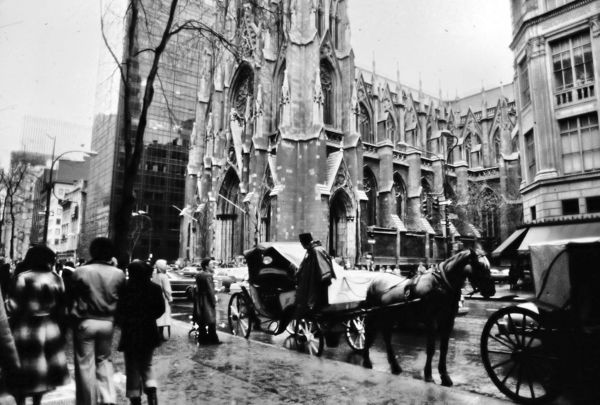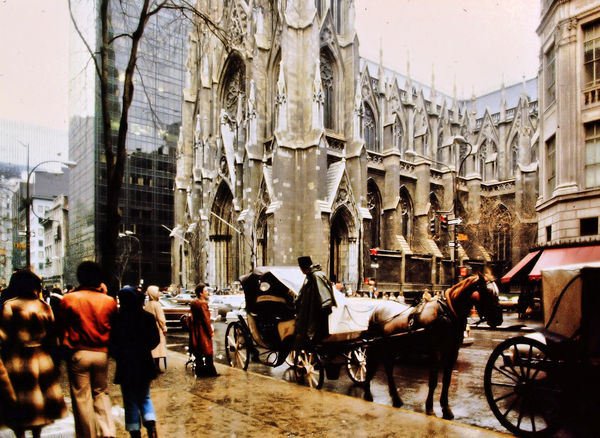Is PP allowed for "Traditional Street Photography"?
Feb 12, 2016 10:05:23 #
Just wondering what people think of post processing street. How about lens distortion correction, perspective correction? Is it a violation of "purity"? What do you think?
I know that the candid shots with slanted composition add to the drama and dynamics of the scene, but not aways...?
I know that the candid shots with slanted composition add to the drama and dynamics of the scene, but not aways...?
Feb 12, 2016 10:53:48 #
Personally I think it is OK.
After all, isn't a lot of B&W immages nowdays due to post processing.
After all, isn't a lot of B&W immages nowdays due to post processing.
Feb 12, 2016 13:07:02 #
It is a good question, but one to which, with time and having seen many published versions of the same images by a number of the greats of traditional street, I have come to give little concern. Some street photographers supposedly were much opposed to any cropping of their images, others, not so much. And comparison of published versions of a number of Cartier-Bresson's well-known images, both as seen in print and on-line, reveals fully as much variation in image characteristics of tonal range and tonal spectra as do the many versions of many of Ansel Adam's famous landscapes.
I'm curious as to other attitudes that may be expressed.
I'm curious as to other attitudes that may be expressed.
Feb 12, 2016 13:52:03 #
Post processing allows a photographer to be more artistic in selecting which part of a captured scene should be emphasized. Mood light can be enhanced; visual distractions can be cropped out or cloned out; color can be brightened or muted; etc. And the photographer can always change his mind, and start again with the original capture.
Feb 14, 2016 00:52:03 #
Rookie, here. One could fill a large building full of books about what I DON'T know about "street photography".
But, I do know this; as I browse through both "Street" and "Architectural and Traditional Street" on UHH, I find myself immediately abandoning the "paintings" ~ the images that scream "shopped!". My mother was a painter and encouraged by her teachers to go "pro". My Dad was an amateur photographer, the grandson of a pioneer "pro" in Northern Colorado. I've seen "paintings" and "photos" a bazillion times. I love both, but for "street", I want to look at "photographs".
But, I do know this; as I browse through both "Street" and "Architectural and Traditional Street" on UHH, I find myself immediately abandoning the "paintings" ~ the images that scream "shopped!". My mother was a painter and encouraged by her teachers to go "pro". My Dad was an amateur photographer, the grandson of a pioneer "pro" in Northern Colorado. I've seen "paintings" and "photos" a bazillion times. I love both, but for "street", I want to look at "photographs".
Feb 14, 2016 06:53:37 #
PP is inevitable. When I hear people say pure or SOOC I immediately think back to my film days and quickly realize that PP began before I loaded the camera; PP began when I decided which film to use then it got more complicated (fun) deciding with film developer to use and at what temperature and how much time and how many agitations and how vigorous of agitation. Then there is printing with dodging and burning not to mention which enlarger the dichro or the condenser and the complications (fun) goes on in choosing what paper, paper developer and then we get into air dry or drum dry on the prints and then there is glossy and matte finishes. And it has been so long since I've done it I'm sure I have missed a point or two.
Personally I think street should not be cropped. The scene should show everything that is going on and what the photographer has to deal with; that is just part of the luck and skill. PP should be kept to a minimum but one man's excess is another man's minimum. Someone would have to write a fairly lengthy paper defining legal limits on points of allowable adjustments. All in all I think much of it will work itself out in time at least in this forum as we constructively critique each other's submissions. IMHO. :wink:
In my opinion, lens distortion correction should be permissible to the point of showing what the eye sees and not how the camera lens performs. The point being, to me, to show what was happening at that place and time. Perspective correction I think is another matter. I think I would have to see some examples. I'm thinking back to film days and tilting easels. That could possibly open a whole new perspective. Just my thoughts. :)
Personally I think street should not be cropped. The scene should show everything that is going on and what the photographer has to deal with; that is just part of the luck and skill. PP should be kept to a minimum but one man's excess is another man's minimum. Someone would have to write a fairly lengthy paper defining legal limits on points of allowable adjustments. All in all I think much of it will work itself out in time at least in this forum as we constructively critique each other's submissions. IMHO. :wink:
In my opinion, lens distortion correction should be permissible to the point of showing what the eye sees and not how the camera lens performs. The point being, to me, to show what was happening at that place and time. Perspective correction I think is another matter. I think I would have to see some examples. I'm thinking back to film days and tilting easels. That could possibly open a whole new perspective. Just my thoughts. :)
Feb 14, 2016 10:40:16 #
waegwan wrote:
In my opinion, lens distortion correction should be permissible to the point of showing what the eye sees and not how the camera lens performs. The point being, to me, to show what was happening at that place and time. Perspective correction I think is another matter. I think I would have to see some examples. I'm thinking back to film days and tilting easels. That could possibly open a whole new perspective. Just my thoughts. :)
Here's an example -- this is an old image scanned from a 40 year old slide with fortunate or unfortunate color shifts (depending on your preference). I am posting these for comments on the idea of how much and what kind of PP is "okay", "good", "bad", "permissible", "pure", "un-pure".
The first has lots of PP to improve on the original scan that was dark and grainy. #2 was obviously converted to B&W. #3 with perspective adjusted.
Feb 18, 2016 14:35:00 #
Is your street photography going to be put forth as fine art, or is it done for journalistic purposes? Once you know what you are creating, you can decide what kind of post work is appropriate.
Feb 18, 2016 15:03:24 #
Nightski wrote:
I really like your question, here, Sandra.Is your street photography going to be put forth as fine art, or is it done for journalistic purposes? Once you know what you are creating, you can decide what kind of post work is appropriate.
From my "rookie" point of view, this is how I currently "divide the truth" of it for myself:
Do I want others to see what I saw*, or do I really want them to "oh & ah!"?
Do I want my camera to capture the moment as it happened, where it happened, or do I want to tell you what I want you to believe?
* (...in reality, what the CAMERA "saw" and recorded ~ however, if the camera got it completely wrong, I would consider doing some relatively limited post processing in an attempt to clarify what I believe I observed).
_Van
Feb 19, 2016 17:41:38 #
The camera never captures exactly what you saw. You choose what people see with your perspective, including some of the things in the frame and excluding others, using a long lens to compress or a wide angle to exaggerate, using the DOF to highlight something, catching something in the light that would not normally be noticed. The capture itself can very much slant the view of things before the PP even begins.
Feb 19, 2016 17:43:05 #
Let me quote lighthouse:
lighthouse wrote:
Ahhh photography .... post processing .... and tru... (show quote)
Feb 21, 2016 11:53:57 #
My original question was not about journalism versus art, or the value of PP for brightening, sharpening, clarifying, or the fact that everyone makes "adjustments" in-camera or after. No, what I was really trying to address is the fact that many great street photos are crooked, have curved and converging verticals. These can be fixed with software lens distortion correction, perspective correction?
For example (not intended as a criticism of these) :
http://www.uglyhedgehog.com/t-369929-1.html
http://www.uglyhedgehog.com/t-369944-1.html
http://www.uglyhedgehog.com/t-362641-1.html
My question is, Is it a violation of "purity" to straighten, or fix lens distortion?
For example (not intended as a criticism of these) :
http://www.uglyhedgehog.com/t-369929-1.html
http://www.uglyhedgehog.com/t-369944-1.html
http://www.uglyhedgehog.com/t-362641-1.html
My question is, Is it a violation of "purity" to straighten, or fix lens distortion?
Feb 21, 2016 12:40:50 #
mallen1330 wrote:
What is pure about an image distorted by a lens? A fisheye lens bends straight lines to an extreme. How is that "pure"?My question is, Is it a violation of "purity" to straighten, or fix lens distortion?
A specialty tilt/shift lens can correct perspective in the camera. The same PoV captured with a standard lens can be similarly 'corrected' in Post Processing. Quite often, the two images are indistinguishable. In my opinion, it is the end result that is important; not the particular process to arrive at that result.
Feb 21, 2016 20:11:38 #
Nikonian72 wrote:
Amen!What is pure about an image distorted by a lens? A fisheye lens bends straight lines to an extreme. How is that "pure"?
A specialty tilt/shift lens can correct perspective in the camera. The same PoV captured with a standard lens can be similarly 'corrected' in Post Processing. Quite often, the two images are indistinguishable. In my opinion, it is the end result that is important; not the particular process to arrive at that result.
A specialty tilt/shift lens can correct perspective in the camera. The same PoV captured with a standard lens can be similarly 'corrected' in Post Processing. Quite often, the two images are indistinguishable. In my opinion, it is the end result that is important; not the particular process to arrive at that result.
If you want to reply, then register here. Registration is free and your account is created instantly, so you can post right away.








